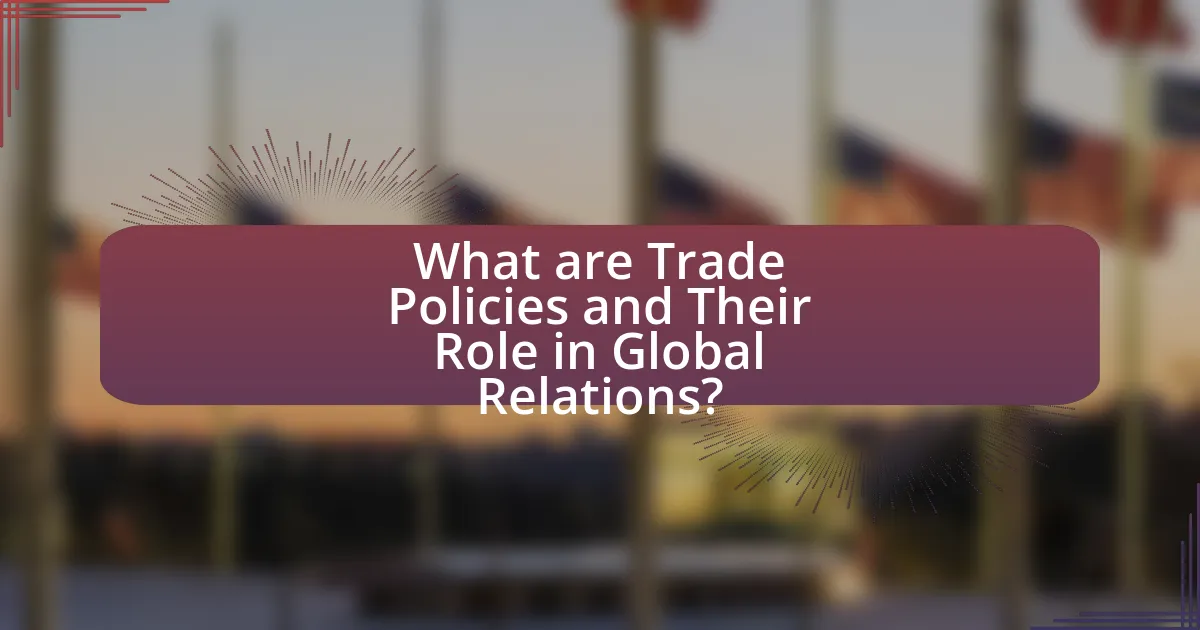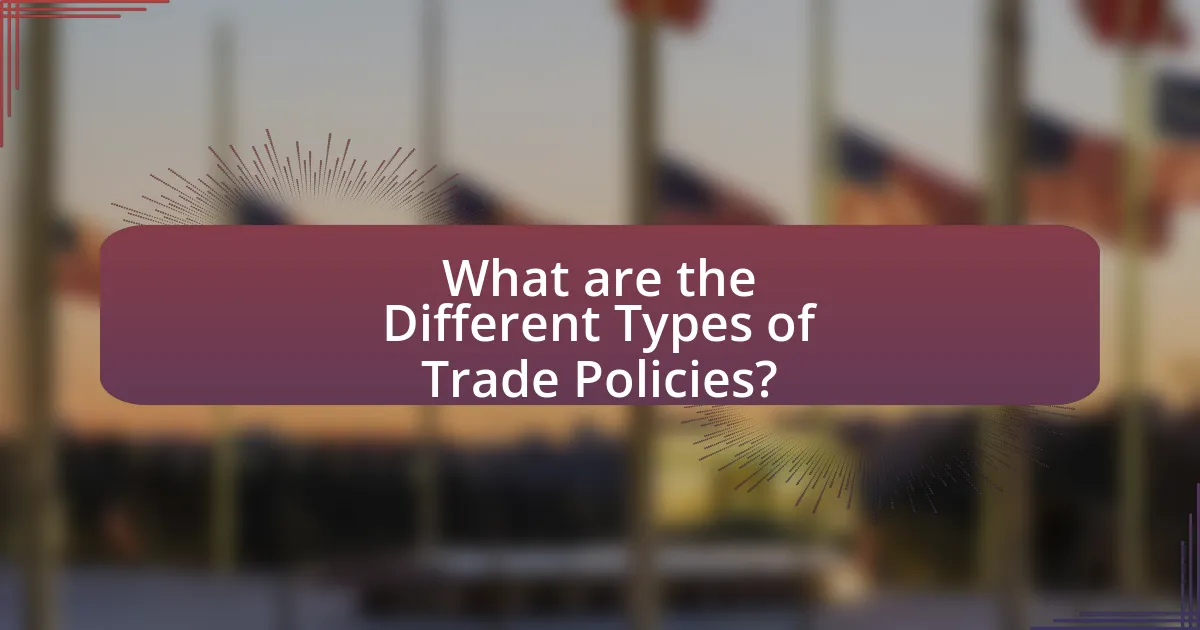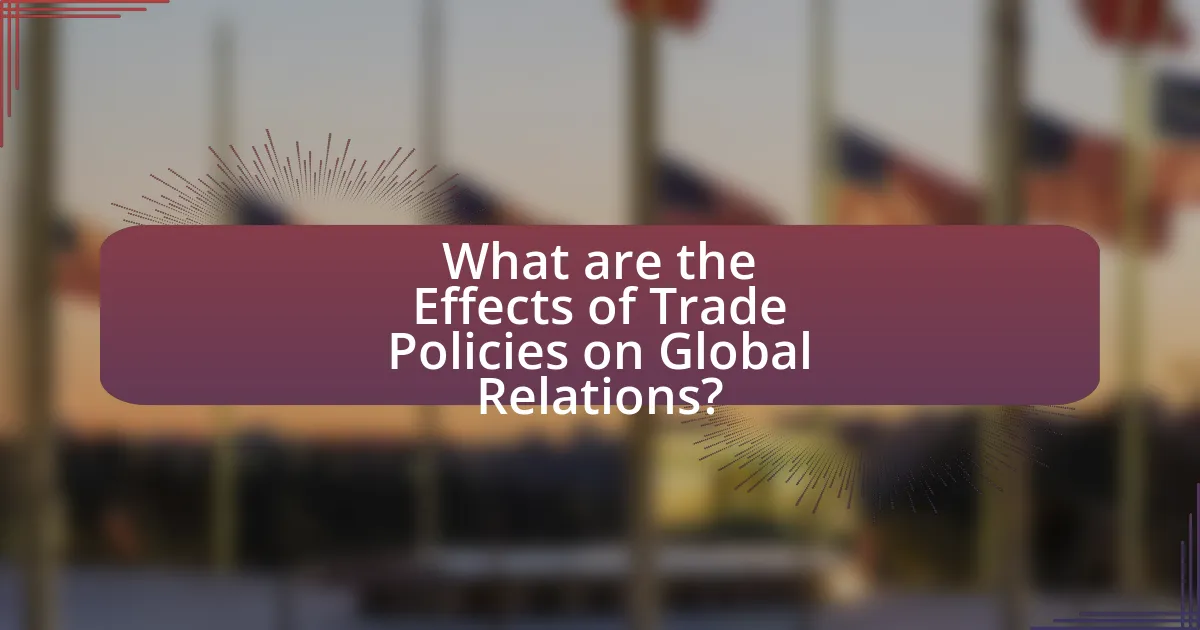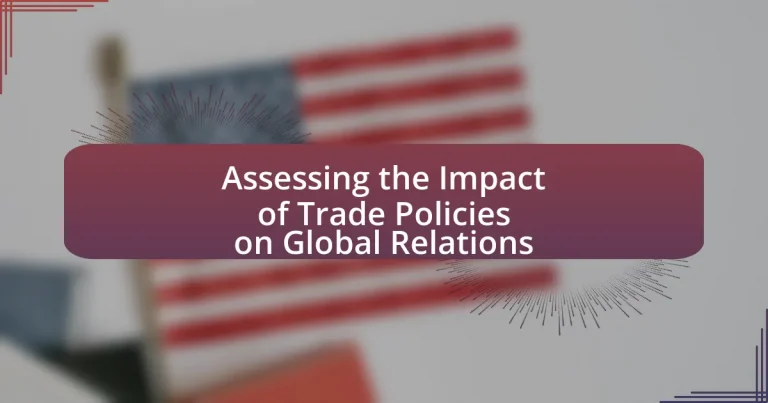Trade policies are essential regulations and agreements that govern international trade, influencing tariffs, import quotas, and export restrictions. They play a significant role in shaping global relations by fostering economic cooperation or creating tensions between nations. The article examines the impact of trade policies on international relations, highlighting key components such as tariffs and trade agreements, and their effects on economic stability, employment rates, and diplomatic ties. It also discusses the challenges faced by developing countries in trade negotiations and the role of international organizations like the World Trade Organization in facilitating trade relations. Additionally, the article explores future trends in trade policies, including sustainability and technological advancements, and offers best practices for balancing protectionism with free trade to enhance global cooperation.

What are Trade Policies and Their Role in Global Relations?
Trade policies are regulations and agreements that countries establish to govern international trade, influencing tariffs, import quotas, and export restrictions. These policies play a crucial role in global relations by shaping economic interactions between nations, promoting trade partnerships, and impacting diplomatic ties. For instance, the North American Free Trade Agreement (NAFTA), implemented in 1994, significantly increased trade between the U.S., Canada, and Mexico, demonstrating how trade policies can enhance economic cooperation and strengthen political relationships. Additionally, trade policies can also lead to tensions, as seen in the U.S.-China trade war, where tariffs imposed by the U.S. aimed to protect domestic industries but resulted in retaliatory measures from China, highlighting the complex interplay between trade policies and global relations.
How do trade policies influence international relations?
Trade policies significantly influence international relations by shaping economic interactions between countries. These policies, such as tariffs, trade agreements, and import/export regulations, can either foster cooperation or create tensions. For instance, the North American Free Trade Agreement (NAFTA) established a framework that enhanced trade relations between the United States, Canada, and Mexico, leading to increased economic interdependence. Conversely, the imposition of tariffs, as seen in the U.S.-China trade war, can escalate conflicts and lead to retaliatory measures, straining diplomatic ties. Thus, trade policies serve as both tools for economic collaboration and potential sources of geopolitical friction.
What are the key components of trade policies?
The key components of trade policies include tariffs, trade agreements, import quotas, and export controls. Tariffs are taxes imposed on imported goods, which can protect domestic industries by making foreign products more expensive. Trade agreements, such as free trade agreements, facilitate trade between countries by reducing or eliminating tariffs and other barriers. Import quotas limit the quantity of specific goods that can be imported, thereby controlling supply and protecting local markets. Export controls regulate the sale of certain goods to foreign countries, often for national security reasons. These components collectively shape a country’s trade environment and influence its economic relationships with other nations.
How do trade agreements shape diplomatic ties?
Trade agreements shape diplomatic ties by fostering economic interdependence and enhancing cooperation between nations. When countries enter into trade agreements, they create frameworks for mutual benefit, which often leads to stronger political relationships. For example, the North American Free Trade Agreement (NAFTA), established in 1994, not only increased trade among the United States, Canada, and Mexico but also strengthened their diplomatic relations through regular dialogues and collaborative initiatives. This interdependence can lead to more stable and peaceful international relations, as countries are less likely to engage in conflict when they have significant economic ties.
Why are trade policies important for economic stability?
Trade policies are crucial for economic stability because they regulate international trade, influencing economic growth, employment, and inflation. By establishing tariffs, quotas, and trade agreements, these policies can protect domestic industries from foreign competition, thereby preserving jobs and stabilizing local economies. For instance, the implementation of protective tariffs can lead to increased domestic production, which supports employment levels and contributes to GDP growth. Additionally, trade policies can mitigate the risks of economic shocks by diversifying trade partners and reducing dependency on a single market. Historical examples, such as the Smoot-Hawley Tariff Act of 1930, demonstrate how restrictive trade policies can lead to economic downturns, highlighting the importance of balanced trade regulations for maintaining economic stability.
What impact do trade policies have on national economies?
Trade policies significantly influence national economies by shaping the flow of goods and services across borders. These policies, which include tariffs, quotas, and trade agreements, directly affect domestic industries, employment rates, and consumer prices. For instance, the implementation of tariffs can protect local businesses from foreign competition, potentially leading to job preservation in certain sectors, but may also result in higher prices for consumers. According to the World Trade Organization, trade liberalization has historically contributed to economic growth, with countries that embrace open trade experiencing GDP growth rates that are, on average, 1.5% higher than those that maintain restrictive trade policies. Thus, trade policies play a crucial role in determining the economic landscape of nations, influencing both macroeconomic stability and individual livelihoods.
How do trade policies affect employment rates globally?
Trade policies significantly influence employment rates globally by shaping market access, competitiveness, and labor demand. For instance, protective trade policies, such as tariffs, can lead to job preservation in certain domestic industries by reducing foreign competition, but may also result in job losses in export-oriented sectors due to retaliatory measures or increased costs. Conversely, liberal trade policies often enhance employment opportunities by facilitating exports and attracting foreign investment, as evidenced by the North American Free Trade Agreement (NAFTA), which is estimated to have created over 1 million jobs in the U.S. by increasing trade flows. Additionally, the World Trade Organization (WTO) reports that trade liberalization can lead to a net increase in jobs, although the distribution of these jobs may vary across different sectors and regions, highlighting the complex relationship between trade policies and employment rates.

What are the Different Types of Trade Policies?
The different types of trade policies include tariffs, quotas, subsidies, and trade agreements. Tariffs are taxes imposed on imported goods, which can protect domestic industries by making foreign products more expensive. Quotas limit the quantity of a specific good that can be imported, thereby controlling supply and protecting local markets. Subsidies are financial support provided by governments to local businesses, allowing them to compete more effectively against foreign imports. Trade agreements, such as free trade agreements, facilitate trade between countries by reducing or eliminating tariffs and other barriers. These policies significantly influence global trade dynamics and international relations.
What are the main categories of trade policies?
The main categories of trade policies are tariffs, non-tariff barriers, trade agreements, and export subsidies. Tariffs are taxes imposed on imported goods, which can protect domestic industries by making foreign products more expensive. Non-tariff barriers include regulations and standards that restrict imports without direct taxation, such as quotas and licensing requirements. Trade agreements, such as free trade agreements, facilitate trade between countries by reducing or eliminating tariffs and other barriers. Export subsidies are financial assistance provided by governments to encourage domestic producers to sell their goods abroad, enhancing competitiveness in international markets. These categories collectively shape global trade dynamics and influence international relations.
How do tariffs and quotas function in trade policies?
Tariffs and quotas are tools used in trade policies to regulate international trade by controlling the amount and cost of imported goods. Tariffs impose a tax on imported products, making them more expensive and less competitive compared to domestic goods, which can protect local industries. For example, the United States imposed tariffs on steel imports in 2018, aiming to bolster its domestic steel industry. Quotas, on the other hand, limit the quantity of a specific good that can be imported, thereby restricting supply and potentially increasing prices. An example is the European Union’s quota on sugar imports, which aims to stabilize local sugar prices. Both tariffs and quotas can influence trade balances, affect consumer prices, and impact international relations by creating tensions between trading partners.
What is the significance of free trade agreements?
Free trade agreements (FTAs) are significant because they facilitate trade by reducing or eliminating tariffs and other trade barriers between participating countries. This reduction in trade barriers leads to increased economic cooperation, enhances market access for exporters, and promotes competition, which can result in lower prices for consumers. For instance, the North American Free Trade Agreement (NAFTA), implemented in 1994, significantly increased trade among the U.S., Canada, and Mexico, with trade volume tripling from $290 billion in 1993 to over $1 trillion by 2016. Such agreements also encourage foreign direct investment, as companies seek to capitalize on the expanded market opportunities created by FTAs.
How do protectionist policies affect global relations?
Protectionist policies negatively impact global relations by creating trade barriers that lead to economic isolation. When countries impose tariffs or quotas, they disrupt the flow of goods and services, which can result in retaliatory measures from trading partners. For instance, the U.S.-China trade war, initiated in 2018, saw both nations impose tariffs on billions of dollars’ worth of goods, leading to strained diplomatic relations and economic uncertainty. Such policies can also hinder international cooperation on broader issues, as countries may prioritize national interests over collaborative efforts, undermining global economic stability and growth.
What are the potential consequences of trade wars?
Trade wars can lead to significant economic consequences, including increased prices for consumers, disrupted supply chains, and reduced economic growth. For instance, the U.S.-China trade war initiated in 2018 resulted in tariffs that raised costs for American importers, which were often passed on to consumers, leading to higher prices on goods. Additionally, businesses faced uncertainty, causing them to delay investments and hiring, which contributed to slower economic growth. According to a report by the International Monetary Fund, trade tensions can reduce global GDP by 0.5% to 1% over time, illustrating the broader economic impact of such conflicts.
How do countries respond to protectionist measures?
Countries respond to protectionist measures primarily through retaliatory tariffs and trade negotiations. For instance, when one country imposes tariffs on imports, affected countries often retaliate by imposing their own tariffs on goods from the initiating country, as seen in the U.S.-China trade war where both nations enacted multiple rounds of tariffs against each other. Additionally, countries may seek to negotiate trade agreements or join international organizations to counteract the effects of protectionism, aiming to restore free trade conditions. This response is evident in the formation of trade blocs like the European Union, which promotes internal trade while countering external protectionist policies.

What are the Effects of Trade Policies on Global Relations?
Trade policies significantly influence global relations by shaping economic interactions between countries. For instance, tariffs and trade agreements can either foster cooperation or lead to tensions. The North American Free Trade Agreement (NAFTA) exemplifies how trade policies can enhance economic ties, resulting in increased trade volume among the U.S., Canada, and Mexico, which reached over $1 trillion in goods and services by 2016. Conversely, protectionist measures, such as those implemented during the U.S.-China trade war, can escalate conflicts, leading to retaliatory tariffs that disrupt global supply chains and economic stability. These examples illustrate that trade policies are pivotal in determining the nature of international relationships, influencing both economic prosperity and diplomatic dynamics.
How do trade policies impact developing countries?
Trade policies significantly impact developing countries by shaping their economic growth, trade balances, and access to global markets. For instance, tariffs and trade barriers can restrict exports from developing nations, limiting their ability to compete internationally and hindering economic development. According to the World Bank, countries that engage in trade liberalization experience an average GDP growth increase of 1.5% annually, highlighting the positive effects of open trade policies. Conversely, protectionist measures from developed countries can lead to trade imbalances, where developing nations face higher costs for imports and reduced market access for their goods. This dynamic can exacerbate poverty and limit opportunities for sustainable development in these regions.
What challenges do developing nations face in trade negotiations?
Developing nations face significant challenges in trade negotiations, primarily due to limited bargaining power and inadequate resources. These nations often lack the technical expertise and financial capacity to effectively engage in complex negotiations, which can lead to unfavorable trade agreements. For instance, according to the World Trade Organization, developing countries represent a smaller share of global trade, making it difficult for them to influence negotiations compared to developed nations. Additionally, they may struggle with domestic political instability and economic vulnerabilities, which can hinder their ability to present a united front in negotiations. These factors collectively contribute to the difficulties developing nations encounter in securing equitable trade terms.
How can trade policies promote sustainable development?
Trade policies can promote sustainable development by integrating environmental and social standards into trade agreements. These policies encourage countries to adopt practices that protect natural resources, reduce carbon emissions, and enhance labor rights. For instance, the inclusion of sustainability clauses in trade agreements, such as the Comprehensive and Progressive Agreement for Trans-Pacific Partnership, mandates adherence to environmental protections and labor rights, fostering a more equitable and sustainable global economy. Additionally, trade policies that support green technologies and renewable energy can stimulate economic growth while addressing climate change, as evidenced by the increase in clean energy investments following the implementation of supportive trade measures.
What role do international organizations play in trade policy?
International organizations play a crucial role in shaping trade policy by facilitating negotiations, establishing rules, and promoting cooperation among countries. Organizations such as the World Trade Organization (WTO) provide a platform for member states to discuss trade agreements, resolve disputes, and ensure compliance with international trade laws. For instance, the WTO’s Trade Facilitation Agreement, implemented in 2021, aims to streamline customs procedures and reduce trade costs, thereby enhancing global trade efficiency. Additionally, international organizations often conduct research and provide technical assistance to developing countries, helping them to integrate into the global trading system effectively. This involvement not only fosters economic growth but also contributes to stability in international relations by promoting fair trade practices and reducing the likelihood of trade conflicts.
How does the World Trade Organization influence trade relations?
The World Trade Organization (WTO) influences trade relations by establishing a framework for negotiating trade agreements and resolving disputes among member countries. This organization promotes free trade by reducing tariffs and other trade barriers, which facilitates smoother international commerce. For instance, the WTO’s Trade Facilitation Agreement, implemented in 2021, aims to expedite the movement of goods across borders, thereby enhancing trade efficiency. Additionally, the WTO provides a platform for member countries to engage in dialogue and negotiations, which helps to prevent trade conflicts and fosters cooperation. The effectiveness of the WTO in influencing trade relations is evidenced by its role in mediating over 500 trade disputes since its inception in 1995, demonstrating its capacity to maintain stability in global trade dynamics.
What are the implications of regional trade agreements?
Regional trade agreements (RTAs) significantly influence economic relations among member countries by facilitating trade through reduced tariffs and streamlined regulations. These agreements often lead to increased trade volumes, as evidenced by the North American Free Trade Agreement (NAFTA), which resulted in a 250% increase in trade between the U.S., Canada, and Mexico from 1993 to 2016. Additionally, RTAs can create trade diversion, where trade shifts from more efficient global producers to less efficient regional partners, potentially leading to inefficiencies in resource allocation. Furthermore, RTAs can enhance political ties and cooperation among member states, fostering stability and collaboration in other areas such as security and environmental policies.
What are the Future Trends in Trade Policies?
Future trends in trade policies are increasingly focused on sustainability, digital trade, and regional trade agreements. Governments are prioritizing environmental standards and carbon reduction in trade agreements, reflecting a global shift towards sustainable practices. Additionally, the rise of e-commerce and digital services is prompting nations to adapt their trade policies to facilitate cross-border digital transactions, as seen in agreements like the US-Mexico-Canada Agreement (USMCA), which includes provisions for digital trade. Furthermore, regional trade agreements are gaining prominence as countries seek to strengthen economic ties within specific areas, exemplified by the Regional Comprehensive Economic Partnership (RCEP) in Asia. These trends indicate a significant evolution in how countries approach trade, emphasizing collaboration, technology, and sustainability.
How is technology changing trade policy frameworks?
Technology is transforming trade policy frameworks by enabling more efficient data exchange, enhancing transparency, and facilitating real-time monitoring of trade flows. Digital platforms and tools, such as blockchain and artificial intelligence, allow for streamlined customs processes and improved compliance with regulations. For instance, the World Trade Organization reported that digital trade can reduce trade costs by up to 20%, demonstrating the significant impact of technology on trade efficiency. Additionally, technology fosters greater collaboration among nations by providing platforms for negotiation and dispute resolution, thereby reshaping traditional trade agreements to be more adaptive and responsive to global market changes.
What are the emerging challenges for global trade relations?
Emerging challenges for global trade relations include rising protectionism, geopolitical tensions, and the impact of technological advancements. Protectionism has increased as countries implement tariffs and trade barriers to safeguard domestic industries, evidenced by the U.S.-China trade war, which saw tariffs imposed on billions of dollars’ worth of goods. Geopolitical tensions, particularly between major economies, disrupt established trade agreements and create uncertainty, as seen in the ongoing conflicts involving Russia and Ukraine, which have affected energy and agricultural markets globally. Additionally, technological advancements, such as automation and digital trade, pose challenges in terms of regulatory frameworks and labor displacement, necessitating new policies to address these shifts.
What Best Practices Should Countries Follow in Trade Policy Development?
Countries should prioritize transparency, stakeholder engagement, and evidence-based decision-making in trade policy development. Transparency ensures that trade policies are clear and accessible, fostering trust among stakeholders. Engaging various stakeholders, including businesses, labor groups, and civil society, allows for diverse perspectives and promotes inclusive policy-making. Evidence-based decision-making relies on data and research to inform policies, enhancing their effectiveness and adaptability. For instance, the World Trade Organization emphasizes the importance of these practices in its guidelines, highlighting that countries with transparent and inclusive trade policies tend to experience more stable and beneficial trade relations.
How can countries balance protectionism and free trade?
Countries can balance protectionism and free trade by implementing targeted trade policies that protect domestic industries while promoting international trade. For instance, they can use tariffs and quotas selectively to shield vulnerable sectors from foreign competition, while simultaneously engaging in free trade agreements that enhance market access for exporters. Historical examples include the United States’ use of tariffs on steel imports to protect its domestic industry, while also participating in trade agreements like NAFTA, which facilitated trade with Canada and Mexico. This dual approach allows countries to safeguard their economic interests without completely isolating themselves from the global market, fostering a more stable economic environment.
What strategies can enhance cooperation among nations?
To enhance cooperation among nations, establishing multilateral trade agreements is essential. These agreements facilitate economic interdependence, which can lead to stronger diplomatic ties and conflict resolution. For instance, the North American Free Trade Agreement (NAFTA) significantly increased trade among the U.S., Canada, and Mexico, fostering closer political relationships and collaboration on various issues. Additionally, promoting cultural exchanges and joint initiatives in areas like climate change can further solidify partnerships, as seen in the Paris Agreement, where countries committed to collective action for a common goal.





